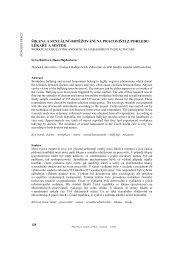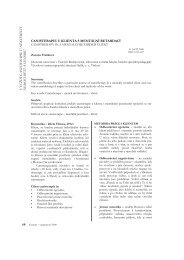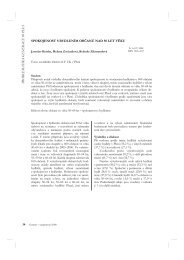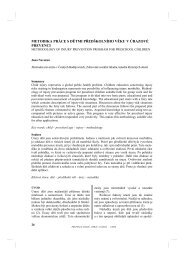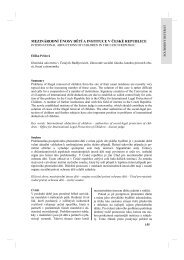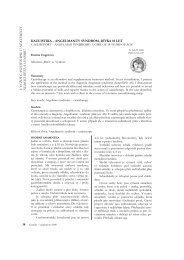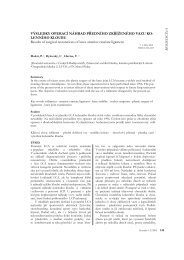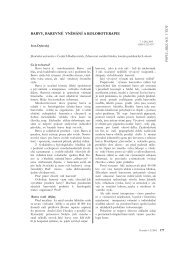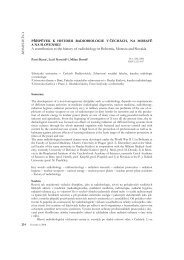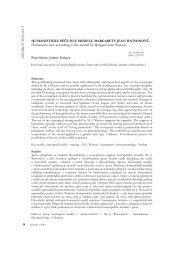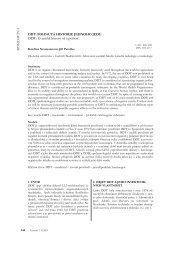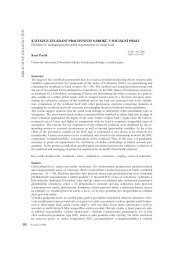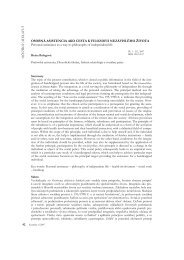REVIEW
REVIEW
REVIEW
Create successful ePaper yourself
Turn your PDF publications into a flip-book with our unique Google optimized e-Paper software.
Jitka Pokorná<br />
Charcot’s osteoarthropathy can appear in<br />
up to 10% of patients with diabetic neuropathy<br />
and 16% of patients with neuropathic<br />
ulcerations. The highest risk is associated<br />
with the patients between 50 and 60 years<br />
of age with the diabetes duration for longer<br />
time than 10 years (Jirkovská 2003). It is a<br />
progressive destructive illness of foot bones<br />
and joints in the patients with a neuropathy.<br />
The exact pathogenetic mechanism isn’t<br />
known.<br />
The causes of diabetic defect emergence:<br />
• chronic low pressure for many hours<br />
(when using improper shoes);<br />
• direct injury (nail, a foreign body in the<br />
shoe);<br />
• chronic slight pressure leading to a blister<br />
and then to an ulcus;<br />
• scald, burns;<br />
• radages, mycoses.<br />
In addition to the above mentioned causes,<br />
some additional illnesses (hypertension,<br />
hyperlipidemia) and the life style of the patient<br />
– smoking – contribute to the pathogenesis.<br />
motor<br />
foot muscles<br />
atrophy<br />
decreased<br />
joint<br />
movability<br />
neuropathy<br />
sensitive<br />
small injury<br />
after stepping<br />
on an object<br />
insensitivity,<br />
painlessness<br />
visceral<br />
defect<br />
diabetes<br />
mellitus<br />
anhydrosis,<br />
edema<br />
skin<br />
fissures<br />
134<br />
An infection in the diabetic foot is<br />
defined as an invasion and multiplication<br />
of microorganisms in the tissue, tissue<br />
destruction and inflammatory response. The<br />
division to 1. no risk for the extremity; 2. risk<br />
for the extremity and 3. risk for the patient<br />
is really practical. Antibiotic therapy of the<br />
infection must always be supplemented with<br />
a complex care, relieve of pressure on the<br />
ulceration, surgery intervention (incisions,<br />
drainages, infected tissue removal via resection<br />
or amputation), débridement of necrotic<br />
tissue, vascular blood supply and metabolic<br />
compensation (Jirkovská 2006b). Infection<br />
in the diabetic foot is often polymicrobial,<br />
but the most common microbial agent is<br />
Staphylococcus aureus that is included in the<br />
common skin flora in the healthy population.<br />
Unfortunately, MRSA (methicilin resistant<br />
Staphylococcus aureus) infections rate increases.<br />
The microbe is resistant to nearly all<br />
the other antibiotics, except of vankomycin<br />
(Kratochvíl et al. 2006).<br />
A-V shunt<br />
edema<br />
blood flow<br />
disorder<br />
hyperviscosity<br />
hyperglycemia<br />
capillary<br />
flow<br />
disorder<br />
chronic<br />
skin<br />
hypoxia<br />
small<br />
injury<br />
infection<br />
atherosclerosis,<br />
smoking,<br />
lipids<br />
Source: Rušavý et al. (1998)<br />
Fig. 1. Pathogenesis of diabetic ulcerations



